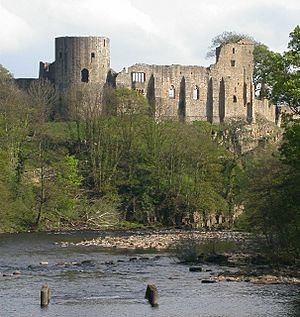Barnard Castle (castle) facts for kids


Barnard Castle is an old, ruined castle in the town of the same name in County Durham, England. It sits high above the River Tees. This castle has a long and interesting history, going back to the 11th century. Today, you can visit its impressive ruins and imagine what life was like there centuries ago.
Contents
Discovering Barnard Castle's Past
How the Castle Began
A stone castle was first built on this spot between 1095 and 1125. It was started by a man named Guy I de Balliol. Before that, there was already a protected area here.
Later, between 1125 and 1185, Guy's nephew Bernard I de Balliol and his son Bernard II de Balliol made the castle much bigger.
Changes in Ownership
In 1216, Alexander II of Scotland, who was the King of Scotland, tried to take the castle. The Balliol family still owned it, but the Bishop of Durham also claimed it.
When John Balliol was no longer King of Scotland in 1296, the castle went to the Bishop of Durham. Around 1300, Edward I of England, the King of England, gave it to the Earl of Warwick.
In the 1400s, the castle became part of the Neville family through marriage. In 1477, during a time of wars called the Wars of the Roses, Richard, Duke of Gloucester, took over the castle. He later became King Richard III and loved staying at Barnard Castle.
The Castle's Decline
Over the next 200 years, the Neville family made the castle even larger and more impressive. But then, a big event happened called the Rising of the North. This was a rebellion against the Queen.
During this time, a soldier named Sir George Bowes defended the castle. He was surrounded and under attack. After the rebellion failed, Charles Neville, 6th Earl of Westmorland, who led the rebellion, lost his lands. The Neville family's properties, including Barnard Castle, were taken by the Crown.
In 1626, the Crown sold Barnard Castle and another Neville property, Raby Castle, to Sir Henry Vane. Sir Henry Vane decided to live at Raby Castle instead. He then took materials like stone and other parts from Barnard Castle to help build and improve Raby. This is why Barnard Castle became a ruin.
Visiting the Castle Today
Today, English Heritage looks after Barnard Castle. It is open for people to visit. You can see the remains of a round tower from the 1100s. There are also parts of the Great hall and Great chamber from the 1300s.
The castle is a very important historical site. It is known as a Scheduled Ancient Monument. It was also listed as a Grade I building in 1950, meaning it is of special historical interest. The ruins of the old chapel of St Margaret are also listed as Grade II.
"Barney Castle" Saying
In the local dialect of County Durham, people sometimes use the phrase "Barney Castle." It means "a pathetic excuse." This saying probably comes from the time when Sir George Bowes was stuck inside the castle during the rebellion. The phrase was even included in a famous dictionary of slang in 1937.


